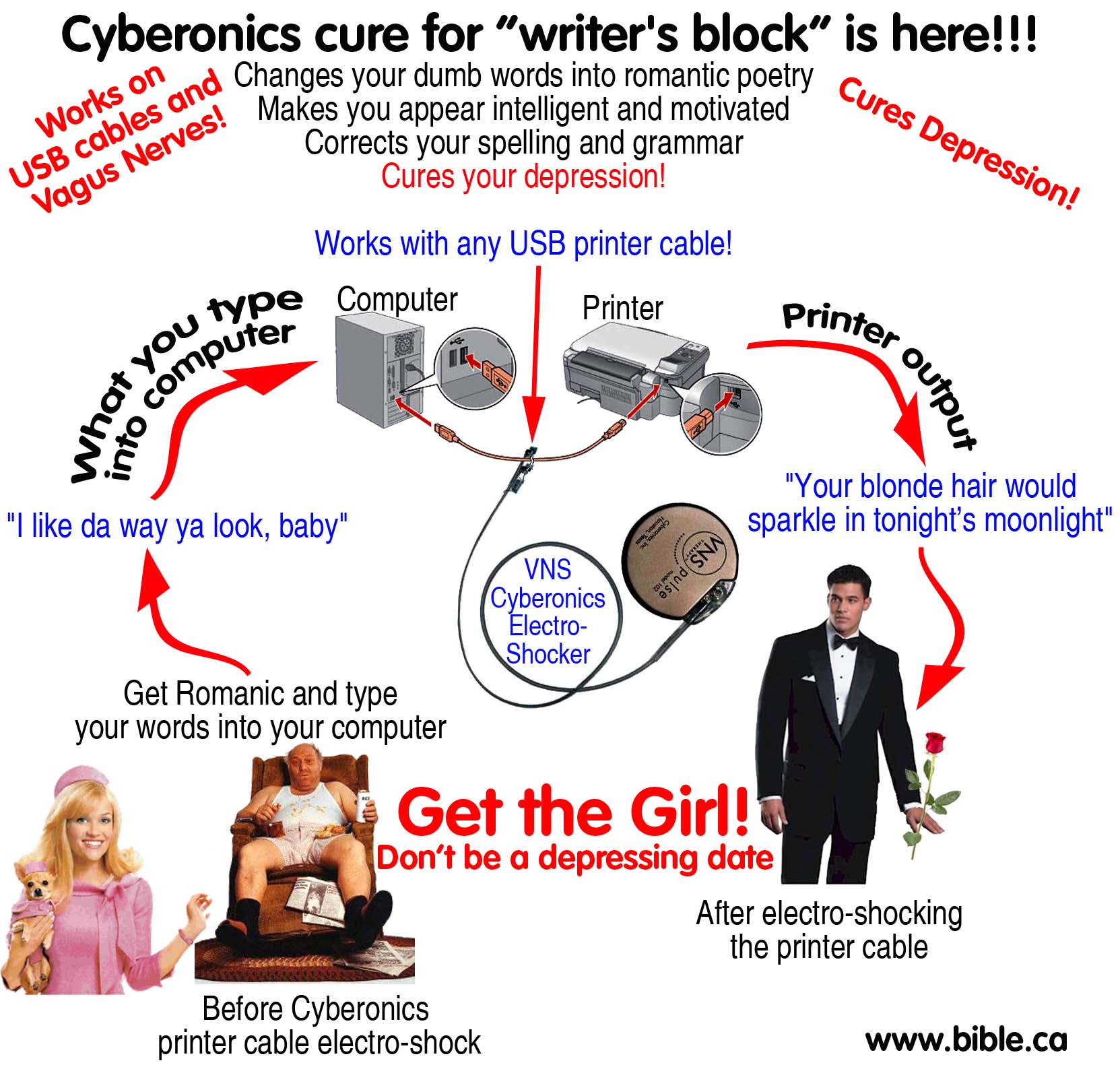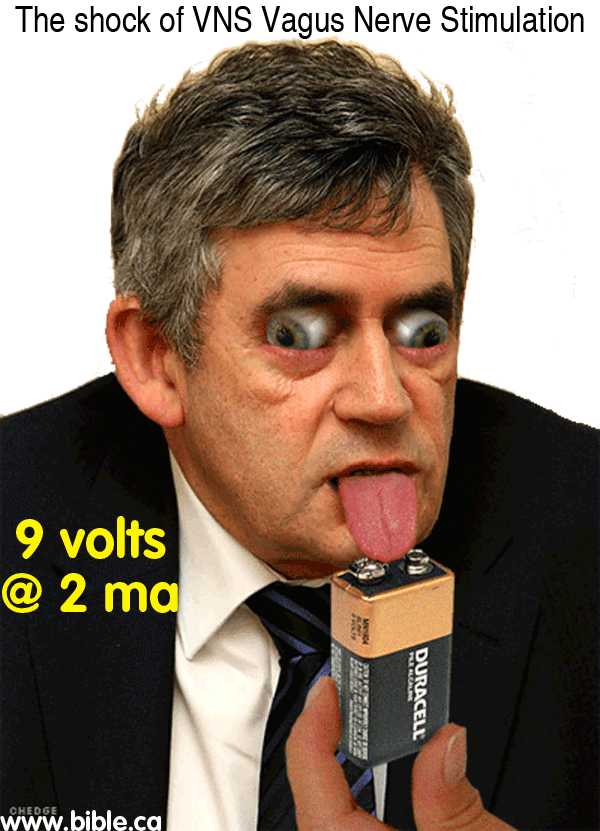Vagus Nerve Stimulation (VNS)
The Cyberonics "Pacemaker of the Vagus Nerve"
Mental Illness Depression Brain
Treatments
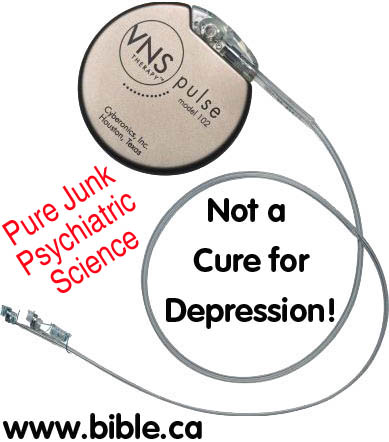
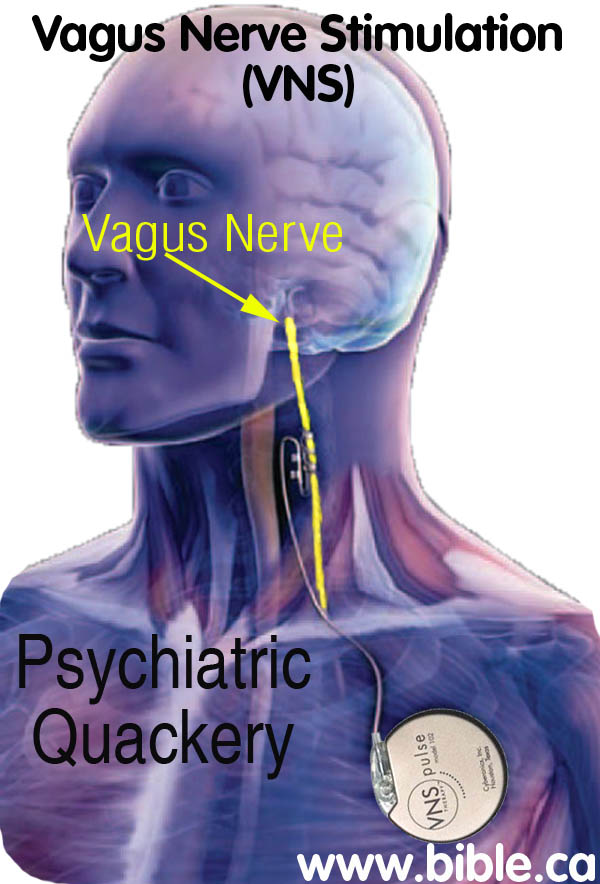
|
|
Summary:
In 2005, the FDA approved the use of Vagus Nerve Stimulation (VNS) for depression. This FDA approval could be summarized this way, "We have no idea if VNS works, but since it doesn't kill people, you can experiment on live guinea pigs who are otherwise unresponsive to any other treatment for depression. FDA approval opened the door for a large scale "clinical trial" of an unproven treatment. VNS is a form of ECT that shocks the brain with up to 12 volts through an electrode wrapped around the vagus nerve in the neck. The nervous system is more like a network cable between the body and the brain. Applying random shocks of electricity to the vagus nerve is destructive and interferes with normal brain function. The nervous system runs on a natural voltage of about 1/10th of a volt. VNS shocks the vagus nerve up to 12 volts, which is 120x the normal voltage the brain uses. Experts admit that the procedure is both experimental and unproven: "Not curative (depression)-Physicians should warn patients that VNS Therapy has not been determined to be a cure for depression." (Introduction to the VNS Therapy, Warnings, and Precautions, Cyberonics inc, Dec 2008, p8) Chemical psychiatry has a long and misguided history of looking to the brain as the etiology of insanity and depression. Chemical psychiatrists reject the Bible's teaching that man has a spirit that consciously survives the death of the brain. They wrongly view the emotions of man as a machine-like response to chemicals and neurons in the brain. The theory behind VNS is pure junk science: "The pulses that are delivered to the left vagus nerve are transmitted to the central nervous system, and they go to specific areas in the central nervous system that control mood, motivation, sleep, appetite, and other symptoms that are relevant to depression." (A. John Rush, MD, Vice Chair, Department of Clinical Sciences Professor, Department of Psychiatry University of Texas) The problem with this theory, is that nerves do not control or even communicate mood or motivation. Nerves transmit commands for muscle movement and sensory information like touch, pain etc. While muscle pain transmitted through nerves to the brain can clearly affect the mood of the spirit, they do not create for control mood or motivation. Mood and motivation has its origin in the spirit, not the body. Obviously, when you apply raw electricity to a digital electrical communication system (human nervous system) it is going to damage and interfere with normal function of the body. Sleep apnea, where you stop breathing for a few seconds while sleeping is a known dangerous side effect of this stupid treatment. Other known side effects include: actual a change in tonal speech sound, pharyngitis and shore throats, larengitis-like hoarseness and coughing, Neck pain, Difficulty swallowing, Tingling or prickling of the skin. All the side effects interfere with physical tissues near the location of the shocks to the vagus nerve. This rather interference with normal bodily function is easily predicable. (More: Vagus Nerve Stimulation)
Introduction:
- Invented in 1997 AD, The Vagus Nerve Stimulation (VNS) applies pulsed DC electric voltage to the left vagus nerve in the neck via a lead wire implanted under the skin. It is like a pacemaker for your vagus nerve.
- Cyberonics inc. is the only manufacturer of this device in the world.
- In 2005, the FDA approved the use of Vagus Nerve Stimulation (VNS) for "treatment resistant depression". This means that psychiatrists can now start experimenting on human guinea pigs (mental patients) to do a real live "clinical trial" of the procedure. "Use (depression)-This device is a permanent implant. It is only to be used in patients with severe depression who are unresponsive to standard psychiatric management. It should only be prescribed and monitored by physicians who have specific training and expertise in the management of treatment-resistant depression and the use of this device. It should only be implanted by physicians who are trained in surgery of the carotid sheath and have received specific training in the implantation of this device." (Introduction to the VNS Therapy, Warnings, and Precautions, Cyberonics inc, Dec 2008, p8)
- "The initial argument for registration of VNS in the United States was that it was already registered for use in Europe. The company pushed for an expedited review, and at an FDA advisory meeting on June 15, 2004, the panel, in a split vote, recommended approval for marketing. Stock prices for Cyberonics, a publicly traded company, jumped. On August 12, however, the FDA made it clear that the trial results were unconvincing, and it did not intend to follow the panel's recommendation. Cyberonics's stock fell. At the start of February 2005, the FDA reopened the possibility of a future approval for VNS, and this time, stock zoomed 3o percent. Finally, on July 15, 2005, it approved VNS for treatment-resistant depression, despite considerable skepticism on the part of some of the panelists regarding whether clinical benefits had been demonstrated." (Shock Therapy: A History of Electroconvulsive Treatment in Mental Illness, Edward Shorter, David Healy, 2007, p 279
- Obviously, when you apply raw electricity to a digital electrical communication system (human nervous system) it is going to damage and interfere with normal function of the body. Sleep apnea, where you stop breathing for a few seconds while sleeping is a known dangerous side effect of this stupid treatment. Other known side effects include: actual a change in tonal speech sound, pharyngitis and shore throats, larengitis-like hoarseness and coughing, Neck pain, Difficulty swallowing, Tingling or prickling of the skin.
- Electrically shocking the brain has a long history in psychiatry and it has
never worked. This new device shocks the verve, not the brain directly.
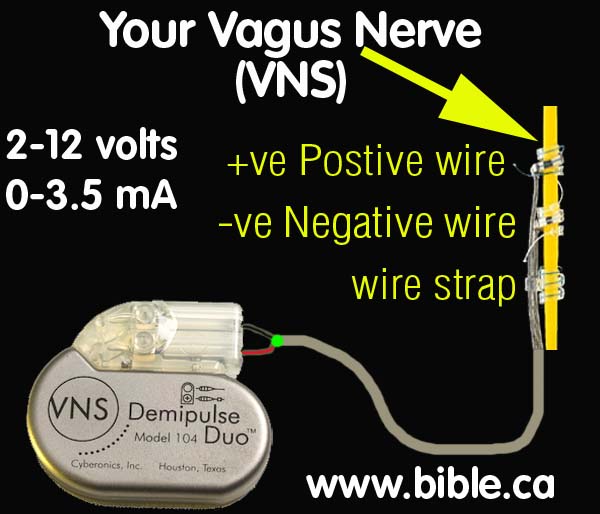
- The suggestion by psychiatrists that the vagus nerve controls mood and motivation is just pure quackery! Moods, motivation and emotions all have their origin in the human spirit not the physical body: "The device delivers very mild intermittent brief pulses to the left vagus nerve. ... The pulses that are delivered to the left vagus nerve are transmitted to the central nervous system, and they go to specific areas in the central nervous system that control mood, motivation, sleep, appetite, and other symptoms that are relevant to depression." (A. John Rush, MD, Vice Chair, Department of Clinical Sciences Professor, Department of Psychiatry University of Texas)
- "It appears that neither psychiatrists, nor the editors of medical and scientific publications, nor the media, nor the public feel the need to reconcile the contradiction of treating the same brain disease with interventions as different as ECT, VNS, DBS, TMS, antidepressant drugs, cognitive therapy, various "talk therapies," and dolphin therapy. At this point, it may be well to recall that the so-called effectiveness of this kind of therapeutic hocus-pocus had been investigated more than two hundred years ago by some of the greatest scientific figures of the time who had no difficulty concluding that the miracle-cure they were examining—Mesmerism—was simply bogus. Just as importantly, they also concluded that because healer and healed are equally deceived and self-deceived, the effectiveness of the hocus-pocus therapy appears real, at least for a while. Then, after they are debunked, they lose their effectiveness and are soon replaced by new miracle cures. Mesmer first used magnets to cure patients. Then his mere touch turned out to be curative. Finally, he didn't even have to touch patients to cure them—they could cure themselves and each other by means of rituals that utilized the powers of an imaginary magnetic fluid, a property of "animal magnetism." Between 1774 and 1777, in a mere three years, Mesmer rose from obscure physician to world-famous healer, only to be exposed as a quack." (Coercion as Cure, Thomas Szasz, 2007 AD, p 148)
- The vagus nerve is nothing more than an electrical wire that sends signals from the human brain down to other physical parts of the body, which also send feedback up the vagus nerve to the brain for processing.
- A quadriplegic has his spinal cord cut in two and it does not affect emotion, thought, mood, motivation one bit. This fact should be all the evidence a scientist needs to reject Vagus Nerve Stimulation as a treatment that will in a few short years, be placed on the shelf beside lobotomy and bloodletting.
A. The shock of Vagus Nerve Stimulation: 12 volts @ 3.5 ma
- The literature you read on VNS says that a tiny amount of electricity is used to shock your brains and nerves. However, the question is this: tiny compared to what? 12 volts @ 3.5 ma is a tiny amount of electricity for a car, but would cause the CPU of a computer to internally explode! We are talking about your brain.
- If you were to power the brain with a battery, it would use a 1/10 of volt battery supply. That is how much voltage typically powers the brain. 0.1v. VNS applies 120 times more voltage than the brain normally uses. To put this into perspective, remember the time you fried your 120 volt hair drying when you traveled abroad? That was twice the voltage and look what it did! Imagine if you applied 100 times the voltage to your hair drying (12,000 volts)! VNS shocks the human brain and nervous system with 120 times higher voltage than it normally operates on.
- All electric treatments in psychiatry use simple electricity... the same stuff your curling iron or a flashlight uses. It is simple electricity.
- We can see from the manufacturer's specifications that all Cyberonics VNS shock devices can produce 12 volts @ 3.5 ma.
- "Output current 0-3.5 mA in 0.25-mA steps 0.25
≤1 mA, 10% >1 mA. For output currents ≤1mA, the tolerance
is ±.25mA. Maximum output is 12.5±2.5V with
the exception of 10 Hz, 7 seconds On Time, in
which case the maximum output is 4.4V and .25mA tolerance. This
.25mA tolerance also applies to 15 Hz, 7 seconds On Time, .5mA output
current. ... Power source: 3.3 V battery, Wilson Greatbatch Ltd., Model
2075, Lithium carbon monofluoride" (Technical Information, 102/102R
Generators, Cyberonics inc, , Dec 2007, p 10)
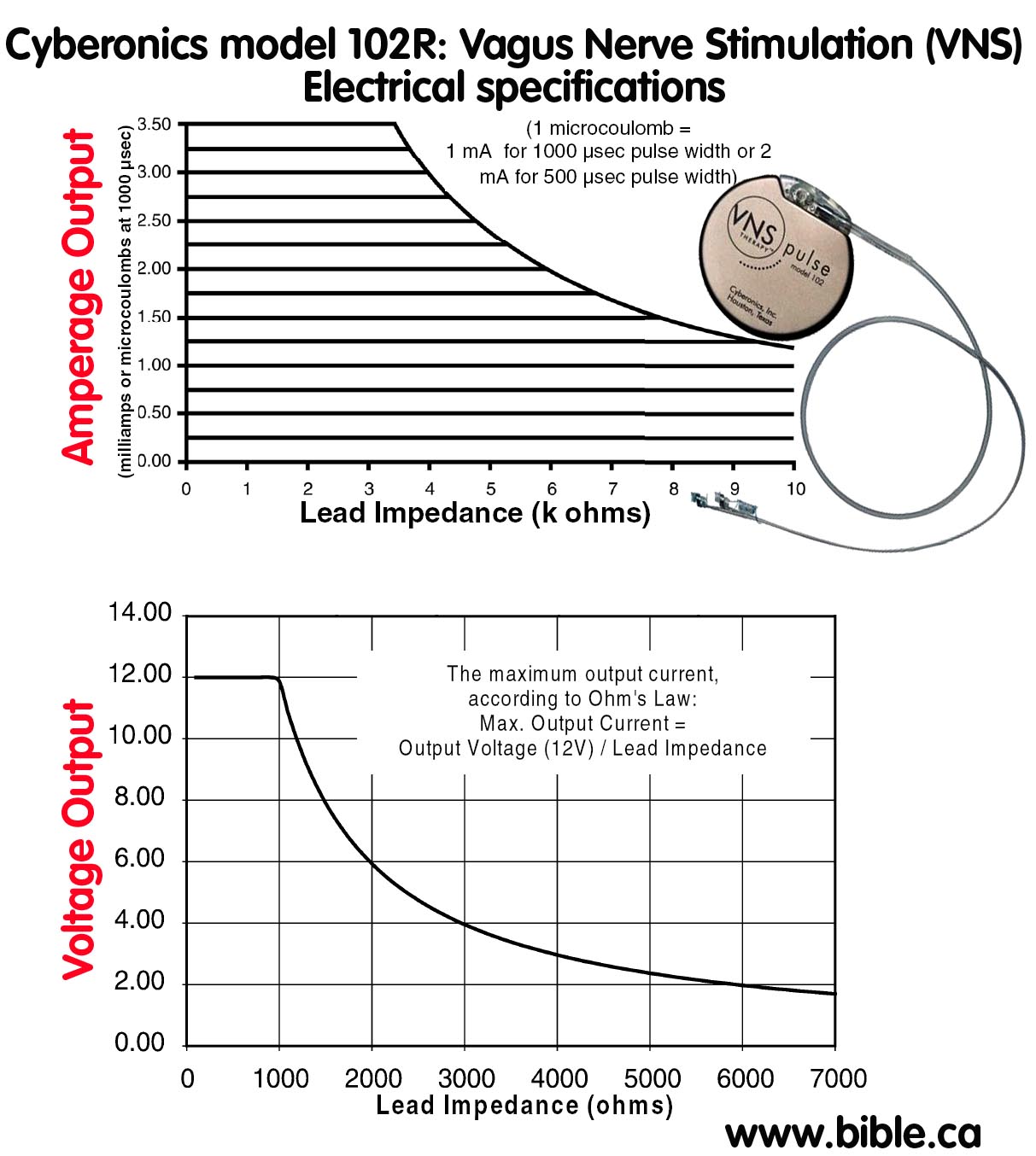
- You might wonder how much "shock" 12 volts @ 3.5 ma feels like. Well fortunately, you can try it yourself by simply touching your wet tongue to a 9 volt battery. But first, touch the battery with your dry fingers. Then with wet fingers... then touch it to your tongue. A nine volt battery is 9 volts @ 2 ma when you touch it to your tongue.
|
|
The Cyberonics VNS nerve shocker
puts out about the same electricity as what you feel when you touch your
tongue to a 9 volt battery. 9v battery: 9 volts @2 ma |
B. Vagus Nerve Stimulation doesn't work!
- All psychiatric treatments for insanity, mental illness or
depression that shock the brain with electricity as a cure, are utterly
worthless, apart from the placebo effect, because insanity is a spiritual
problem, not a physical disease. Applying electricity to the brain to cure
insanity, is like applying household electricity to your computer's
central processor to fix a software issue. Using ECT, rTMS, VNS, DBS is
about as effective as fixing your computer with your car jump starter! The
human brain is the hardware, the software is located in the spirit.

- Of course this doesn't surprise Christians, who understand that man has a spirit that is distinct from his body. The Christian understands from the Bible story of Luke 16:21, that when we die and our brain becomes dust, that we retain our memories, will, desires and emotions. Depression is a spiritual problem, not a physical disease.
- "VNS is far from being the only problematic new treatment on the block, however. The late 1990s also saw the emergence of deep brain stimulation (DBS), a treatment linked to what may be potentially even greater problems than those related to VNS." (Shock Therapy: A History of Electroconvulsive Treatment in Mental Illness, Edward Shorter, David Healy, 2007, p 280)
- This device is absolutely unproven and is highly experimental.
- Theoretically, Vagus Nerve Stimulation cannot work. It is impossible to altar emotions and will (depression) by shocking the brain or nerves.
- "Not curative (depression)-Physicians should warn patients that VNS Therapy has not been determined to be a cure for depression. Patients should be counseled to understand that individual results will likely vary. Beneficial results might not become evident for months. Most patients will continue to require antidepressant medications and/ or electroconvulsive therapy (ECT) in addition to VNS Therapy." (Introduction to the VNS Therapy, Warnings, and Precautions, Cyberonics inc, Dec 2008, p8)
- Notice it is for the depressed who do not respond to any other kind of treatment. This is code language for: "To be used for wards of the state that are costing tax dollars and we have nothing to lose from experimenting on them as guinea pigs."
- If your doctor has recommended this device to you, it means you are at the end of the line in psychiatric treatment and at the bottom of the barrel of human life. Of course, if they want to try this device on you, you are likely going to be treated against your will and without your consent so it doesn't matter any way. Welcome to the world of psychiatric coercion.
- "Use (depression)-This device is a permanent implant. It is only to be used in patients with severe depression who are unresponsive to standard psychiatric management. It should only be prescribed and monitored by physicians who have specific training and expertise in the management of treatment-resistant depression and the use of this device. It should only be implanted by physicians who are trained in surgery of the carotid sheath and have received specific training in the implantation of this device." (Introduction to the VNS Therapy, Warnings, and Precautions, Cyberonics inc, Dec 2008, p8)
C. Side effects of Vagus Nerve Stimulation:
- There are a number of huge and dangerous side effects of VNS treatment.
- The most common side effect is that over half of patients experience changes in their voice.
- "After a decade of VNS treatment for epilepsy, the therapy has been linked to a number of deaths. The FDA dismissed these fatalities as not yet replicated in the case of depression treatment. More to the point, the notion of mood stabilization—the idea that anticonvulsant treatments act by quenching kindling in both mood and convulsive disorders— rests on shaky ground. In June 2005, a controlled trial including more than 1,800 epilepsy patients showed there was little reason to think anticonvulsants diminished the risk of subsequent seizures." (Shock Therapy: A History of Electroconvulsive Treatment in Mental Illness, Edward Shorter, David Healy, 2007, p 279)
- The most dangerous side effect is sleep apnea that is seen in over 14% of patients. That means 1 in 7 will stop breathing in the middle of their sleep and wake up gasping and out of breath... unless they die of asphyxiation.
- "MRI-Patients with the VNS Therapy System or any part of the VNS Therapy System implanted should not have full body MRI. Additional surgery may be required to remove the VNS Therapy system if full body MRI is required." (Introduction to the VNS Therapy, Warnings, and Precautions, Cyberonics inc, Dec 2008, p8)
|
Side effects of Cyberonics VNS Therapy implant for Depression: |
||
|
Adverse Event |
0-3 Months (N=232) |
9-12 Months (N=209) |
|
Voice Alteration |
135 (58.2%) |
113 (54.1%) |
|
Increased Cough |
55 (23.7%) |
13 (6.2%) |
|
Neck Pain |
38 (16.4%) |
27 (12.9%) |
|
Dyspnea: shortness of breath, sleep apnea |
33 (14.2%) |
34 (16.3%) |
|
Dysphagia: difficult swallowing |
31 (13.4%) |
9 (4.3%) |
|
Paresthesia: pins and needles |
26 (11.2%) |
9 (4.3%) |
|
Laryngismus: spasm of the larynx |
23 (9.9%) |
10 (4.8%) |
|
Pharyngitis: sore throat. |
14 (6.0%) |
11 (5.3%) |
|
Nausea |
13 (5.6%) |
4 (1.9%) |
|
table
1. adverse events reported during VNS therapy at 0-3 months and 9-12 months |
||
D. Cyberonics cure for "romantic writer's block" is here!!!
|
|
What you send to the printer: "I like da way ya look, baby" What actually gets printed after you shock the USB cable: "Your blonde hair would sparkle in tonight's moonlight" |
|
|
|
- Vagus Nerve Stimulation for depression is pure junk science. It is psychiatric quackery at its best!
- Emotions and motivation do not have anything to do with the vagus nerves because they have their origin in the human spirit and not any part of the body.
- Nerves function exactly like USB cables that connect a computer to a printer. A nerve carries signals from the brain to a muscle and back again.
- Trying to alter emotion or motivation by applying an electric shock to a nerve, is exactly like tying to change the printed output of a document you are printing, by shocking the USB cable!
- Imagine you type in a letter and save it on the computer. Then you print that document. As the computer sends the document to the printer through the USB cable, do you think randomly shocking the USB cable with raw electricity is going to correct spelling, grammar or make any alterations at all? At best, it might wipe out sections of the printed page or replace it with random garbled print, but no improvement could possibly be expected.
- This is why the idea of shocking the vagus nerve with electricity to cure depression is pure quackery!
E. VBS disrupts normal brain function: "Lesions"
- When VBS shocks the vagus nerve, it disrupts normal brain function. This really is no surprise to any one who took the grade 9 introductory electricity course. In technical terms, this disruption is called a "lesion".
- Lesioning is like when your computer freezes for a moment during a power surge. All activity in the CPU stops while the power surge occurs. When the surge is over the CPU picks up where it left off.
- Electrical lesioning fixes a fibrillating heart. Arrhythmia is when the heart beats in an irregular or spasmodic rhythm. Atrial fibrillation occurs when the heart's electrical system makes the atria to quiver or "fibrillate". Different parts of the heart beat at different rates which means blood is no longer being pumped efficiently. The solution is a heart "Defibrillator" which we have all seen in emergency wards where the nurse puts two electrode paddles over the heart and on the side of the chest. "All clear", then zap! The shock makes the body jump off the bed, but the heart beat is reset back to normal rhythm. The is a prefect example of how electricity creates a lesion and saves a person's life. Applying "defibrillator" theory to correcting emotions by shocking the brain, is completely different matter and doesn't work.
- "As with TMS, DBS depends on neuro-imaging technology. In order to implant the electrodes in the correct location, it is necessary to be able to map each patient's brain in great detail using both MRI and CT scans, fusing these with computer programs to get a precise fix on the path of nerve tracts and blood vessels. A misplaced electrode can cause hemorrhage and death. The 2004 remake of The Manchurian Candidate gives a reasonably accurate image of what the procedure looks like. When the electrodes are in place, a battery operated device produces a stimulation that can be increased or decreased in frequency based on feedback from the patient. This stimulation can theoretically work by either overstimulating nerve cells, leading to somatic fatigue, or jamming the nerve cells so signals do not get through, in either case producing a functional lesion." (Shock Therapy: A History of Electroconvulsive Treatment in Mental Illness, Edward Shorter, David Healy, 2007, p 281)
- "When physical treatments like DBS were initially applied to Parkinson's disease, clear and relatively discrete brain circuits were sought as sites for stimulation. But this did not necessarily mean that those involved in the field were seeking to attack the root of the illness. Many researchers readily conceded that all they may be doing is to produce compensatory responses, or indeed inducing further brain dysfunction, in order to balance out the original disturbance, whatever that might be. For instance in Parkinson's disease, the stimulation of the subthalamic nucleus produces therapeutic effects but does not do so by correcting the initial abnormality. The effect is to produce a compensatory lesion that, as it were, rebalances the system rather than corrects the problem." (Shock Therapy: A History of Electroconvulsive Treatment in Mental Illness, Edward Shorter, David Healy, 2007, p 287)
Conclusion:
- Depression happens in the spirit, not the physical body.
- Vagus Nerve Stimulation for depression is pure junk
pop-psychiatry and makes the "junk psychiatry
O-meter" go crazy!
 (Left: Junk pop-psychiatry O-meter going crazy)
(Left: Junk pop-psychiatry O-meter going crazy) - The entire application of VNS to depression is entirely theoretical and unproven.
- VNS has some important applications in treating known physiological diseases like epilepsy. The difference between epilepsy and depression is that you can conduct scientific tests for epilepsy, but not for depression. Epilepsy is an electrical problem with the brain that affects motor control of the body.
- The error of chemical psychiatrists, is rooted in their atheistic belief in evolution that man is nothing more than a pile of chemicals and electrons. They openly mock Christians who view the nature of man is dichotomous, having a distinct body and soul. This error has "dead ended" psychiatric research into insanity in the physical brain as the etiological cause of insanity for 300 years. "It is not important whether this cerebroversion hypothesis is correct; the point is to highlight modern psychiatry's failure of imagination. At the start of the twenty-first century, thinking has been dominated by "bio-babble," a discourse characterized by jargon and an emphasis on the monoamines, dopamine, serotonin, and norepinephrine. Within a few years, this will almost certainly seem as vacuous as Freudian notions about libido. The problem, in the meantime, is that just as psychoanalysis once inhibited a generation from making progress in understanding what mental disorders are, so too psychopharmacology has held back development in theoretical aspects of psychiatry, at the expense of patients." (Shock Therapy: A History of Electroconvulsive Treatment in Mental Illness, Edward Shorter, David Healy, 2007, p 296)
- VNS is the "new kid on the street" that is has captured researchers attention to find some treatment for depression. They will fail when they look for the problem in the physical body. "Time will tell whether another chapter in the history of shock therapy is being written today or not. The history of the past sixty years has been a history of successive attempts to improve ECT. All have failed, even if individual lives were helped along the way. The treatment that Cerletti described in 1938, plus a few modifications involving muscle relaxation and wave form, is still with us today, and a row of bright ideas about magnets, nonconvulsive applications of electricity, and the like have not succeeded in making patient care better or safer. It remains to be seen if the current therapies will provide more convincing alternatives." (Shock Therapy: A History of Electroconvulsive Treatment in Mental Illness, Edward Shorter, David Healy, 2007, p 289)
- A quadriplegic has his spinal cord cut in two and it does not affect emotion, thought, mood, motivation one bit. This fact should be all the evidence a scientist needs to reject Vagus Nerve Stimulation as a treatment that will in a few short years, be placed on the shelf beside lobotomy and bloodletting.
- At present, there is no evidence Vagus Nerve Stimulation has any more effect on curing depression, or any mental illness, than might be expected as the placebo effect.
By Steve Rudd: Contact the author for comments, input or corrections.
Send us your story about your experience with modern Psychiatry
